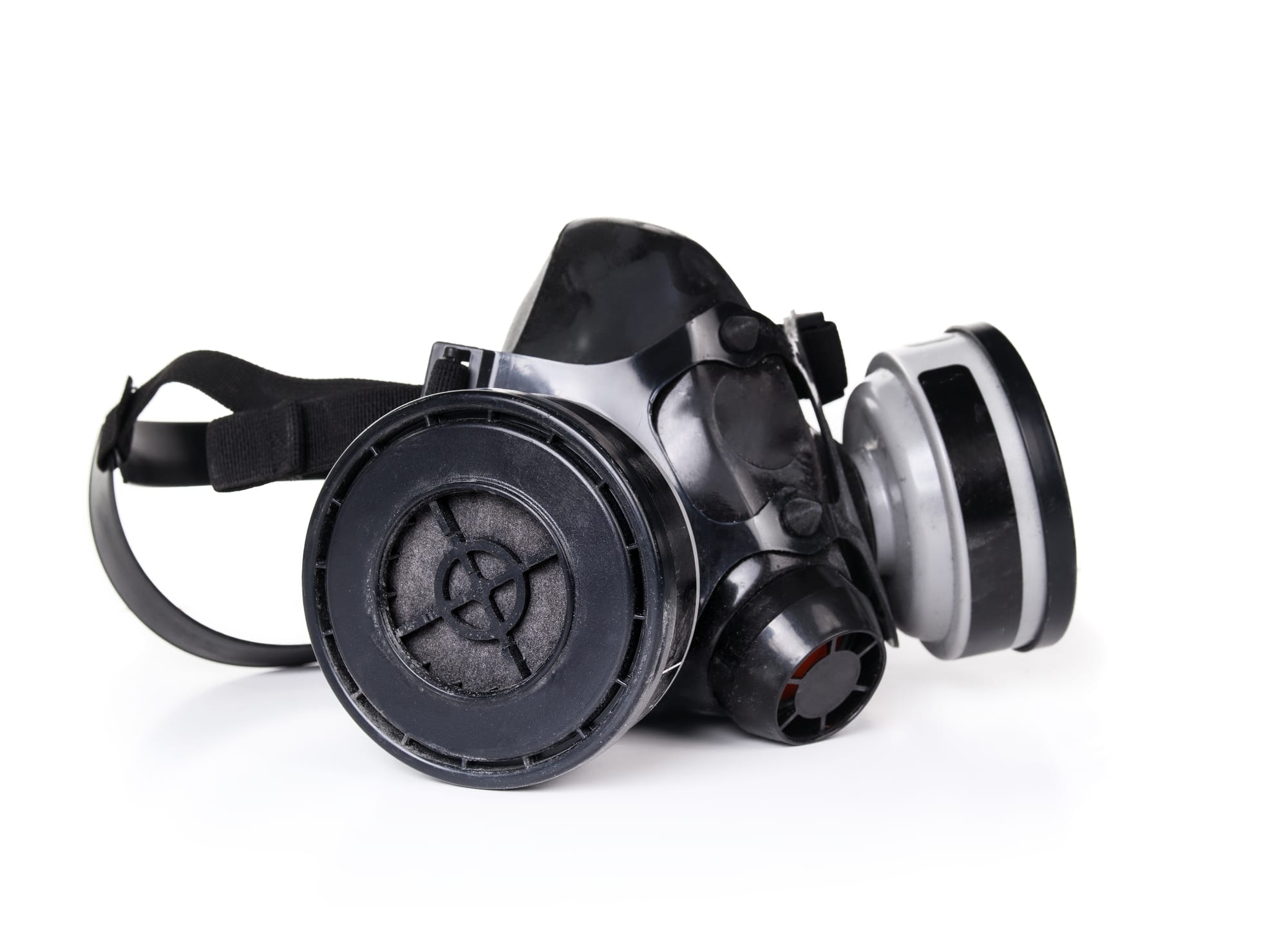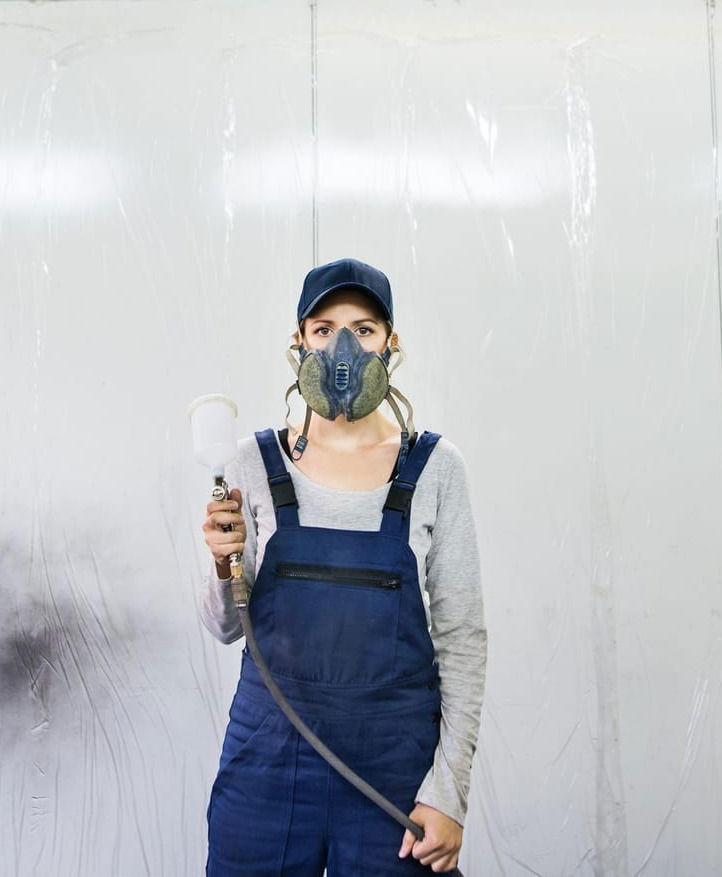Dealing with Paint Fumes and Health Risks

Key Highlights of the Article
- Understanding the composition and sources of paint fumes is crucial for safety.
- Recognizing short-term and long-term health risks associated with paint fumes.
- Implementing best practices for minimizing exposure, including choosing low-VOC paints and ensuring proper ventilation.
- Lightmen Painting’s commitment to using safe painting practices and prioritizing client health.
Dealing with Paint Fumes
Painting can transform a space, but it’s crucial to understand the potential health risks associated with paint fumes. This is a lesson I learned firsthand during a particularly challenging project where the client’s sensitivity to fumes nearly derailed the entire job. Managing paint fumes effectively became the key to ensuring their comfort and ultimately, their satisfaction. Addressing paint fumes isn’t just about convenience—it’s about health and well-being, both for those applying the paint and those living in the painted environment.
Understanding Paint Fumes
What Are Paint Fumes?
Paint fumes are more than just an unpleasant smell; they’re a complex mix of chemicals that can have serious health implications if not managed properly. These fumes primarily come from Volatile Organic Compounds (VOCs), which are organic chemicals that vaporize and release gases into the air as paint dries. VOCs are found in many paints, particularly oil-based ones, and are responsible for that strong "new paint" smell we all recognize.
VOCs can include a variety of harmful chemicals, such as formaldehyde, benzene, and toluene, among others. These substances can cause short-term effects like headaches, dizziness, and nausea, and long-term exposure has been linked to more severe health issues, including respiratory problems and even certain cancers. Understanding the composition of paint fumes is the first step in mitigating their risks.
Common Sources of Paint Fumes
Not all paints are created equal when it comes to fume production. Oil-based paints, for instance, are notorious for their high VOC content, which is why they tend to produce stronger fumes. On the other hand, water-based or latex paints generally emit fewer VOCs, making them a more environmentally friendly and health-conscious choice.
However, the type of paint isn’t the only factor to consider. The specific circumstances of a painting project can also influence fume levels. For example, painting large areas with inadequate ventilation, or using multiple layers of paint, can increase the concentration of fumes in a space. Projects that involve priming, especially with oil-based primers, can also contribute significantly to the presence of paint fumes.
In Our Experience:
"We've found that addressing paint fumes not only ensures the immediate safety of our clients but also enhances their long-term satisfaction and health. Proper ventilation, choice of low-VOC paints, and thorough site preparation have markedly improved outcomes in our projects, leading to healthier, happier homes."
Health Risks Associated with Paint Fumes
When you’re planning a painting project, it’s easy to focus on colors, finishes, and aesthetics. However, one crucial aspect often gets overlooked—paint fumes and their potential health risks. It’s a topic that deserves attention, especially if you’re planning to spend a significant amount of time in the freshly painted space or if you’re painting in a poorly ventilated area.
Short-Term Health Effects
In the short term, exposure to paint fumes can cause a range of uncomfortable symptoms. Headaches, dizziness, and nausea are the most common complaints, especially when working with high-VOC (Volatile Organic Compounds) paints. I remember a project where the homeowners decided to stay in the house while we painted their kitchen. Despite using fans and keeping windows open, the strong smell of the paint caused headaches and a general feeling of unease for the family. These symptoms usually disappear once the fumes dissipate, but they can be quite disruptive and unpleasant in the meantime.
These effects are primarily caused by VOCs, which are chemicals that evaporate into the air as the paint dries. Inhaling these compounds, even in the short term, can irritate the eyes, nose, and throat. For most people, these symptoms are mild and temporary, but they can be more severe for those with sensitivities or pre-existing conditions.
Long-Term Health Risks
The long-term health risks associated with repeated or prolonged exposure to paint fumes are even more concerning. Chronic exposure to high levels of VOCs has been linked to serious health issues, including respiratory problems, liver and kidney damage, and even cancer. Some studies suggest that professional painters and those frequently exposed to paint fumes may have a higher risk of developing these conditions over time.
One significant concern is the presence of chemicals like formaldehyde and benzene in some paints. These substances are classified as carcinogens, meaning they have the potential to cause cancer with prolonged exposure. Even if you’re only painting occasionally, it’s worth considering these risks and taking steps to minimize your exposure.
Vulnerable Populations
Certain groups are particularly vulnerable to the effects of paint fumes. Children, for instance, have developing respiratory systems and may be more sensitive to the chemicals in paint. Pregnant women should also take extra precautions, as some studies have linked VOC exposure to developmental issues in unborn children. Additionally, individuals with pre-existing health conditions like asthma or other respiratory issues may find their symptoms exacerbated by paint fumes.
Minimizing Exposure to Paint Fumes
Now that we understand the risks, let’s talk about how to minimize your exposure to paint fumes during your next painting project. It’s not just about choosing the right paint—although that’s a big part of it—but also about using the right techniques and equipment to protect yourself and your loved ones.
Choosing Low-VOC and Zero-VOC Paints
One of the best ways to reduce your exposure to harmful paint fumes is to choose paints with low or zero VOC content. These products have become increasingly popular as more people recognize the health risks associated with traditional paints. Low-VOC paints emit fewer chemicals into the air, making them a safer choice for indoor projects. Zero-VOC paints go a step further by eliminating VOCs altogether.
At Lightmen Painting, we’ve had great success with brands like Benjamin Moore’s Natura line and Sherwin-Williams’ Harmony paint, both of which offer excellent coverage and durability without the harsh fumes. While these paints might be slightly more expensive, the investment in your health is well worth it.
Proper Ventilation Techniques
Even with low-VOC or zero-VOC paints, proper ventilation is crucial. Ventilation helps to dissipate any fumes that are present, reducing the concentration in the air and making the environment safer to work in. The goal is to create a constant flow of fresh air through the space.
Here’s what works well: open as many windows and doors as possible to allow for cross-ventilation. Position fans strategically to blow air out of the room rather than circulating it within the space. If the weather allows, keep the windows open not just during the painting process but for several days afterward to ensure all residual fumes are cleared out.
Protective Gear and Equipment
Personal protective equipment (PPE) is another essential aspect of safely handling paint fumes. A good-quality respirator mask that’s designed to filter out VOCs is a must, especially if you’re working in an enclosed space or with high-VOC products. Don’t just settle for a basic dust mask; it won’t offer the protection you need against chemical fumes.
In addition to masks, wearing gloves and protective clothing can help prevent skin contact with the paint, which is particularly important when working with oil-based products or primers. Eye protection is also recommended to avoid irritation from splashes or fumes.

Best Practices for Safe Painting
When it comes to painting, safety should be a top priority, especially in ensuring that the process doesn’t leave harmful fumes lingering in your home. From preparation to post-painting cleanup, there are several best practices that can help minimize fume exposure and keep the air quality in your space safe and healthy.
Preparing the Space
Preparing your space before painting is the first critical step in minimizing fume exposure. It’s not just about clearing out furniture; it’s about creating an environment that supports safe and efficient painting. One of the key steps is to ensure proper ventilation. Before you even crack open that first can of paint, open windows and doors to allow for cross-ventilation. This simple step ensures that fresh air can circulate through the room, reducing the concentration of fumes.
In a recent Lightmen Painting project, we were tasked with repainting an old home with minimal ventilation. To address this, we strategically placed fans at entry points to draw fresh air into the space while exhausting paint fumes out of the windows. This technique made a significant difference in maintaining air quality throughout the project.
Additionally, it’s essential to cover floors, furniture, and other surfaces with drop cloths to prevent paint splatters and spills. Use painter’s tape to seal off areas you don’t want to paint, which also helps in reducing the risk of accidental contamination.
Application Techniques
The method you choose for applying paint can also impact the amount of fumes generated. Sprayers, while efficient for large areas, can create a fine mist of paint particles that linger in the air, potentially increasing fume exposure. In contrast, brushes and rollers produce fewer airborne particles, making them a safer option for indoor painting.However, if you opt for sprayers, make sure to use a high-efficiency airless sprayer that reduces overspray and paint mist. These sprayers are designed to deliver a smooth, even coat with less waste, which also means fewer fumes.
For smaller projects or detailed work, brushes and rollers remain the go-to tools. They not only limit fume production but also give you more control over the application, reducing the need for multiple coats and further minimizing fume exposure.
Post-Painting Cleanup
Once the painting is done, the cleanup process is just as important in ensuring that your space remains safe and fume-free. Proper disposal of paint and cleaning of equipment should be handled with care. Leftover paint should be sealed tightly and stored in a cool, dry place to prevent it from emitting fumes over time.For cleaning brushes and rollers, use the appropriate cleaning agents—water for latex paints and mineral spirits for oil-based paints. Be sure to clean these tools in a well-ventilated area to avoid breathing in any residual fumes.
Before reoccupying the space, give it ample time to air out. Keep windows open and fans running for several hours or even days, depending on the ventilation and the type of paint used. This ensures that any lingering fumes are fully dissipated before you settle back in.
Addressing Paint Fumes After Painting
Even with the best preparation and application techniques, some fumes may still linger after the paint has dried. Addressing these fumes effectively is crucial for maintaining a healthy indoor environment.
Air Purifiers and Dehumidifiers
One of the most effective ways to reduce indoor air pollution from paint fumes is to use air purifiers. High-quality air purifiers with HEPA filters can capture airborne particles, including those from paint, while activated carbon filters are particularly effective at removing VOCs (volatile organic compounds). For spaces prone to high humidity, dehumidifiers can also help by reducing moisture levels, which can accelerate the off-gassing of VOCs.
In my experience, placing an air purifier in the painted room for several days after the project significantly improves air quality. For example, after completing a basement renovation, we used a combination of an air purifier and a dehumidifier. Within 48 hours, the space was not only odor-free but also felt fresher and more comfortable.
Natural Remedies
If you prefer a more natural approach to improving indoor air quality, consider using plants known for their air-purifying properties. Plants like spider plants, peace lilies, and English ivy are excellent at absorbing VOCs and other pollutants from the air.
I once had a client who was very conscious of using natural methods to improve her home’s air quality. After painting her living room, she placed several air-purifying plants around the space. Not only did these plants help reduce the lingering smell, but they also added a beautiful touch to the room’s decor.
Ongoing Maintenance
Maintaining a healthy indoor environment goes beyond the immediate aftermath of a painting project. Regular cleaning and ongoing ventilation are key to preventing the buildup of indoor pollutants. Dust and vacuum surfaces regularly to remove particles that may have settled during the painting process. Additionally, consider installing an air exchange system or regularly using fans to keep fresh air circulating throughout your home.
For long-term strategies, consider using paints with low or zero VOC content for future projects. This choice not only benefits your health during the painting process but also contributes to better indoor air quality over time.
Things to Know
- Health First: Understanding and mitigating the risks of VOCs is crucial for anyone embarking on a painting project.
- Product Choice Matters: Choosing the right paint can significantly impact indoor air quality and overall health.
- Preparation is Key: Properly preparing your space and employing effective ventilation strategies are essential for safe painting.
- Protective Measures: Utilizing protective gear and following best practices can prevent health issues and ensure a successful project outcome.
- Professional Advice: Consulting with experienced professionals like Lightmen Painting can provide peace of mind and ensure that health-conscious practices are meticulously applied.
Lightmen Painting’s Commitment to Safe Painting Practices
At Lightmen Painting, we understand that a beautifully painted space should also be a healthy one. Over the years, we’ve honed our techniques and expanded our expertise to ensure that our painting practices not only meet the highest aesthetic standards but also prioritize the health and safety of our clients and team members.
Our Expertise and Experience
When it comes to safe painting practices, experience is key. At Lightmen Painting, our team brings a wealth of experience to every project, backed by rigorous training and certifications that keep us up-to-date with the latest in safety standards and techniques. Each of our painters is well-versed in identifying potential health risks associated with different types of paint, including the volatile organic compounds (VOCs) that can linger in the air long after the paint has dried.
I recall one particular project where we were tasked with repainting a historic home. The existing paint was old and likely contained harmful substances. Our team’s expertise in safe paint removal and the careful application of low-VOC paints ensured not only a stunning final result but also a healthier environment for the family moving in. This is just one example of how our knowledge and training make a difference in every job we undertake.
Client-Centered Approach
Our commitment to safety extends beyond just following the rules—it’s about putting our clients at the heart of everything we do. From the initial consultation to the final walk-through, we prioritize your health and safety in every step of the process. We begin each project by discussing the safest options for your home, including the selection of low-VOC or zero-VOC paints that minimize harmful emissions.
Our client-centered approach doesn’t end there. We go the extra mile to ensure that your home remains livable during the painting process. This might involve creating safe zones, scheduling work during hours when you’re not at home, or using specialized equipment to control and reduce the spread of fumes.
One of our clients recently shared their appreciation for our attention to safety. They mentioned how they were concerned about painting their nursery due to the potential health risks. We recommended and used a zero-VOC paint, and they were thrilled not only with the beautiful result but also with the peace of mind knowing their baby’s room was safe. Stories like this remind us why our focus on safety is so essential.
Innovative Solutions
Innovation is at the core of our approach to safe painting practices. We constantly seek out new technologies and methods that allow us to minimize health risks while delivering top-quality results. This includes using state-of-the-art air purifiers during and after painting to ensure any lingering fumes are quickly and effectively removed from the space.
We also stay on the cutting edge of product selection, choosing paints and primers that not only look great but are also designed with health and safety in mind. Our commitment to eco-friendly products goes hand in hand with our dedication to safe painting practices. By opting for paints that have lower environmental impacts, we reduce the presence of harmful chemicals in your home, creating a safer environment for you and your family.
For instance, in a recent commercial project, we utilized a new line of eco-friendly paints that not only exceeded the client’s expectations in terms of durability and finish but also contributed to achieving LEED certification for the building. It’s this kind of innovative thinking that sets Lightmen Painting apart and underscores our commitment to safe, sustainable practices.
Conclusion
Addressing the health risks associated with paint fumes is not just an option—it’s a responsibility that we at Lightmen Painting take seriously. From our deep expertise and client-centered approach to our innovative solutions and use of eco-friendly products, we are dedicated to ensuring that every project we undertake is as safe as it is beautiful.
We encourage everyone to make safe painting practices a priority in their homes and workplaces. By choosing low-VOC products and working with professionals who are committed to your well-being, you can enjoy the transformation of your space without compromising on health.
If you’re ready to experience a painting service that puts your safety first, contact Lightmen Painting. Let us help you create a space that’s not only visually stunning but also healthy and safe for everyone who lives, works, and plays in it.
Do You Have Questions? Give Us A Call With Any & All! 503-389-5758
-
People Also Ask:
What are paint fumes and what risks do they pose?
Paint fumes consist mainly of Volatile Organic Compounds (VOCs) and other chemicals released as paint dries. These fumes can cause short-term health effects such as headaches, dizziness, and nausea, and long-term exposure may lead to more severe health issues including respiratory problems and organ damage.
How can I minimize exposure to harmful paint fumes during a project?
Minimizing exposure to paint fumes involves selecting low-VOC or zero-VOC paints, ensuring proper ventilation during the painting process, and using protective gear like masks and gloves. Employing these measures can significantly reduce the health risks associated with paint fumes.
Are there specific paints that emit fewer fumes?
Yes, low-VOC and zero-VOC paints emit fewer harmful chemicals compared to traditional paints. These environmentally friendly options are highly recommended, especially in enclosed spaces or areas frequented by children, pregnant women, and individuals with pre-existing health conditions.
-
SUBSCRIBE TO OUR BLOG: Stay informed with the latest in Painting and DIY projects by subscribing to Lightmen Painting. Get insights, tips, and more delivered straight to your inbox. We would also love to know what you would like to read about, leave thoughts on where we should go next. Interests, Topics, Ideas, all are welcome.
If your in the Portland, Or. area and need advice or a free no obligation estimate call us at 503-389-5758 or email scheduling@lightmenpainting.com
Shout Out:
Celebrating Blue Painting: Excellence in Quality and Craftsmanship
From the team at Lightmen Painting, we extend our highest praise to Blue Painting for their dedication to delivering exceptional painting services. Just as we strive for excellence and meticulous craftsmanship, Blue Painting excels in transforming residential and commercial spaces with their expert skills and professional approach. Their unwavering commitment to quality and customer satisfaction aligns perfectly with our mission to provide top-tier painting solutions that enhance and beautify environments.
Thanks for stopping by Lightmen Daily! Stay tuned for more practical tips and expert advice on making your painting projects flawless, from wall to floor!
Definitions
- Volatile Organic Compounds (VOCs): Organic chemicals that have a high vapor pressure at ordinary room temperature, causing significant vapor emissions.
- Low-VOC Paints: Paints formulated with lower levels of volatile organic compounds, making them safer for indoor use.
- Zero-VOC Paints: Paints with negligible levels of volatile organic compounds, offering the safest option for indoor air quality.
- Protective Gear: Equipment such as masks, gloves, and goggles that protect users from harmful exposure to paint fumes.
- Ventilation: The process of introducing fresh air into a space to disperse and dilute airborne contaminants.
- Air Purifiers: Devices that remove contaminants from the air in a room to improve indoor air quality.
- Dehumidifiers: Appliances that reduce the level of humidity in the air, important for speeding up the drying process of paints and reducing paint fume concentration.
- Stain-Blocking Technology: Paint technology that prevents stains from penetrating through new paint, commonly used in primers.
- Eco-Friendly Paints: Paints that are formulated to have minimal environmental impact, often characterized by low-VOC or zero-VOC formulations.
- Health-Conscious Painting Practices: Methods and products used in painting that prioritize the health and safety of individuals and the environment.
Lightmen Painting Serving: Portland, Tigard, Lake Oswego, Tualatin, West Linn, Milwaukie, Sherwood, Happy Valley, Oregon City, Beaverton, Hillsboro, Gresham -Trade Partners-

